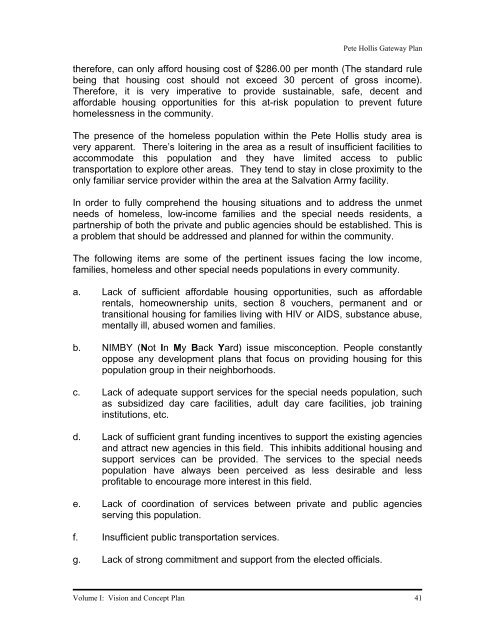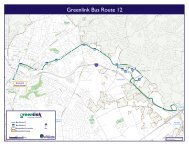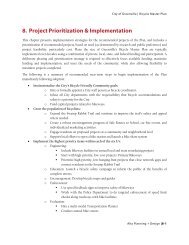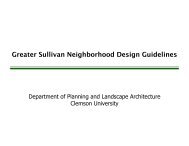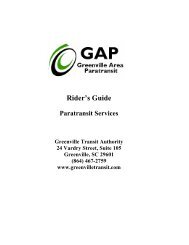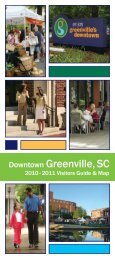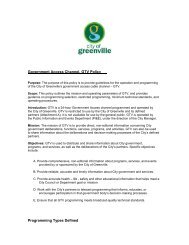Pete Hollis Gateway Plan - City of Greenville
Pete Hollis Gateway Plan - City of Greenville
Pete Hollis Gateway Plan - City of Greenville
Create successful ePaper yourself
Turn your PDF publications into a flip-book with our unique Google optimized e-Paper software.
<strong>Pete</strong> <strong>Hollis</strong> <strong>Gateway</strong> <strong>Plan</strong><br />
therefore, can only afford housing cost <strong>of</strong> $286.00 per month (The standard rule<br />
being that housing cost should not exceed 30 percent <strong>of</strong> gross income).<br />
Therefore, it is very imperative to provide sustainable, safe, decent and<br />
affordable housing opportunities for this at-risk population to prevent future<br />
homelessness in the community.<br />
The presence <strong>of</strong> the homeless population within the <strong>Pete</strong> <strong>Hollis</strong> study area is<br />
very apparent. There’s loitering in the area as a result <strong>of</strong> insufficient facilities to<br />
accommodate this population and they have limited access to public<br />
transportation to explore other areas. They tend to stay in close proximity to the<br />
only familiar service provider within the area at the Salvation Army facility.<br />
In order to fully comprehend the housing situations and to address the unmet<br />
needs <strong>of</strong> homeless, low-income families and the special needs residents, a<br />
partnership <strong>of</strong> both the private and public agencies should be established. This is<br />
a problem that should be addressed and planned for within the community.<br />
The following items are some <strong>of</strong> the pertinent issues facing the low income,<br />
families, homeless and other special needs populations in every community.<br />
a. Lack <strong>of</strong> sufficient affordable housing opportunities, such as affordable<br />
rentals, homeownership units, section 8 vouchers, permanent and or<br />
transitional housing for families living with HIV or AIDS, substance abuse,<br />
mentally ill, abused women and families.<br />
b. NIMBY (Not In My Back Yard) issue misconception. People constantly<br />
oppose any development plans that focus on providing housing for this<br />
population group in their neighborhoods.<br />
c. Lack <strong>of</strong> adequate support services for the special needs population, such<br />
as subsidized day care facilities, adult day care facilities, job training<br />
institutions, etc.<br />
d. Lack <strong>of</strong> sufficient grant funding incentives to support the existing agencies<br />
and attract new agencies in this field. This inhibits additional housing and<br />
support services can be provided. The services to the special needs<br />
population have always been perceived as less desirable and less<br />
pr<strong>of</strong>itable to encourage more interest in this field.<br />
e. Lack <strong>of</strong> coordination <strong>of</strong> services between private and public agencies<br />
serving this population.<br />
f. Insufficient public transportation services.<br />
g. Lack <strong>of</strong> strong commitment and support from the elected <strong>of</strong>ficials.<br />
Volume I: Vision and Concept <strong>Plan</strong> 41


